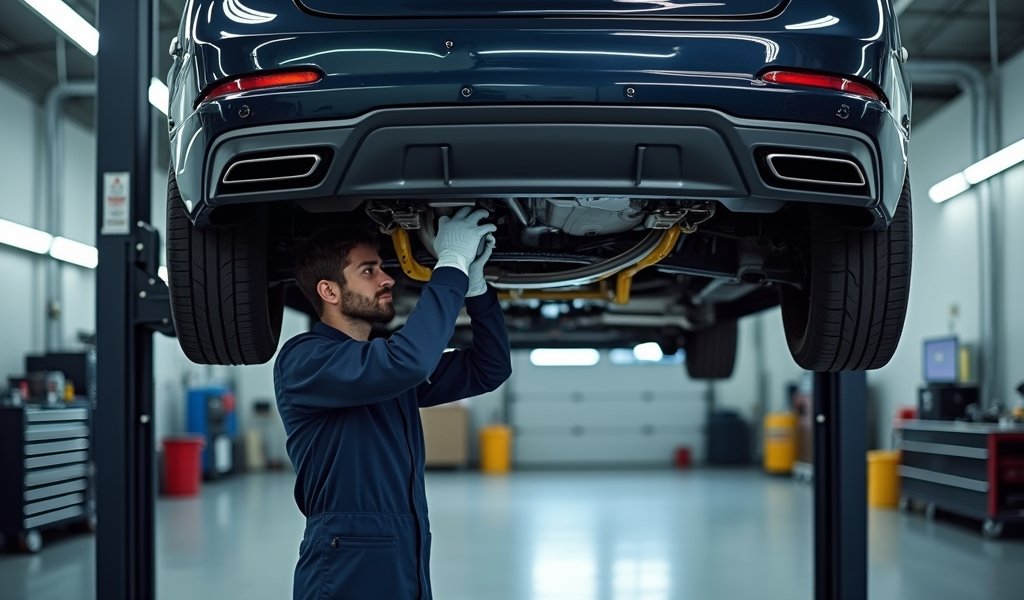Overview
This article explains fuel filter maintenance, emphasizing replacement schedules (30,000-50,000 miles for gasoline engines, 15,000-25,000 miles for diesel), signs of failure (poor performance, hard starting, engine stalling), DIY replacement steps, and seven tips to extend filter life. It covers cost factors for professional versus DIY replacement, helping drivers make informed maintenance decisions to prevent expensive engine damage and maintain optimal vehicle performance.
Table of Contents
- Understanding Fuel Filters: What They Do and Why They Matter
- Signs Your Fuel Filter Needs Replacement
- Recommended Replacement Schedules for Different Vehicles
- DIY Fuel Filter Replacement: Step-by-Step Guide
- Professional vs. DIY Replacement: Making the Right Choice
- 7 Essential Maintenance Tips to Extend Fuel Filter Life
- Understanding the Cost Factors of Fuel Filter Replacement
- Conclusion: Keeping Your Fuel System Happy
- Frequently Asked Questions
Understanding Fuel Filters: What They Do and Why They Matter
The fuel filter replacement schedule is something many drivers overlook until problems arise. As a mechanic with over 15 years of experience, I can tell you that this small component plays a crucial role in your vehicle’s performance and longevity.
Your fuel filter acts as the guardian of your engine’s fuel system. Its primary job? To catch contaminants, dirt, rust, and other unwanted particles before they reach your engine. Think of it as a bouncer for your fuel system – keeping the troublemakers out.
Modern vehicles typically use either in-line filters (located along the fuel line between the tank and engine) or in-tank filters (situated inside the fuel tank itself). Both types serve the same purpose but differ in accessibility and replacement methods.
Without a properly functioning fuel filter, contaminants can reach your engine’s fuel injectors or carburetor, potentially causing thousands of dollars in damage. That’s why following a proper car maintenance schedule by mileage that includes fuel filter checks is so important.
The good news? With proper maintenance, you can avoid these costly repairs and keep your vehicle running smoothly for years to come. Let’s dive into how you can tell when your filter needs attention.
Signs Your Fuel Filter Needs Replacement
Even if you’re not keeping track of your fuel filter replacement schedule, your car will usually give you some hints when things aren’t right. Think of these as your vehicle’s way of waving a red flag.
The most common symptom of a clogged fuel filter is a noticeable decrease in engine performance. You might feel your car struggling, especially during acceleration or when climbing hills. It’s similar to how you might struggle to breathe through a clogged nose – your engine simply can’t get the fuel it needs.
Hard starting is another telltale sign. If your car cranks longer than usual before starting, your fuel filter might be restricting flow to the point where your engine struggles to get going. This is particularly noticeable in cold weather when fuel flow is already compromised.
Watch out for engine stalling or misfiring, especially at high speeds. This happens because your engine demands more fuel during acceleration, and a clogged filter can’t keep up with the increased demand.
That check engine light on your dashboard? It could be triggered by a restricted fuel filter causing lean running conditions. Modern vehicles are equipped with sensors that detect when the air-fuel mixture isn’t optimal, according to Car and Driver’s research.
Lastly, decreased fuel efficiency might indicate a struggling fuel system. When your engine can’t get proper fuel flow, it compensates by working harder, burning more fuel in the process.
If you notice any of these symptoms, it’s time to check your owner’s manual for the recommended fuel filter replacement schedule or head to your mechanic for a diagnostic.

Recommended Replacement Schedules for Different Vehicles
When it comes to the fuel filter replacement schedule, there’s no one-size-fits-all answer. Different vehicles have different requirements based on their design, fuel system, and manufacturer recommendations.
For most traditional gasoline-powered vehicles, mechanics typically recommend replacing the fuel filter every 30,000 to 50,000 miles. However, this is just a general guideline. Your new car service schedule might specify a different interval.
Diesel-powered vehicles often require more frequent fuel filter replacements. Diesel fuel can contain more contaminants than gasoline, putting extra strain on the filter. For these vehicles, a replacement every 15,000 to 25,000 miles is common practice.
Luxury and high-performance vehicles might have their own specific requirements. Some BMW models, for instance, recommend fuel filter replacements at 60,000 miles, while certain Mercedes-Benz vehicles suggest intervals of up to 100,000 miles.
Modern vehicles with in-tank fuel filters often have extended replacement intervals. Some manufacturers now claim these filters are “lifetime” components that don’t require regular replacement under normal conditions. However, “lifetime” typically means the expected life of the vehicle (around 150,000 miles) rather than truly forever.
The type of driving you do also matters. If you frequently drive on dusty roads, in extreme temperatures, or use lower-quality fuels, you might need to replace your fuel filter more often. Think of it like changing your home’s air filter more frequently if you live in a dusty environment.
Always consult your vehicle’s owner’s manual for the manufacturer’s specific recommendations. This document is your car’s personal maintenance guide and should be your first reference for all service intervals.
DIY Fuel Filter Replacement: Step-by-Step Guide
Replacing a fuel filter yourself can save you money and give you a better understanding of your vehicle. Before starting, check how often you should service your car to see if it’s time for other maintenance too.
First things first: safety is paramount when working with fuel systems. Always work in a well-ventilated area, have a fire extinguisher nearby, and relieve the fuel system pressure before beginning. This usually involves removing the fuel pump fuse and running the engine until it stalls.
For accessible in-line fuel filters, here’s a simplified step-by-step approach:
- Gather your tools: new filter, line wrenches, catch pan, and safety glasses
- Locate your fuel filter (usually along the fuel line or mounted on the frame rail)
- Release pressure from the fuel system following your vehicle’s specific procedure
- Place a catch pan under the filter to collect any fuel spillage
- Remove the filter clamps or brackets holding it in place
- Carefully disconnect the fuel lines (they might be secured with quick-connect fittings or clamps)
- Note the direction of fuel flow on the old filter – the new one must be installed in the same orientation
- Install the new filter, making sure it’s facing the correct direction
- Reconnect fuel lines and secure all clamps and brackets
- Reinstall the fuel pump fuse and check for leaks
In-tank filters are considerably more challenging to replace and often require dropping the fuel tank. Unless you have experience with automotive repair, these are best left to professionals. The procedure involves draining and removing the fuel tank, accessing the fuel pump assembly where the filter is located, and carefully replacing the component.
After replacement, turn the ignition key to the “on” position a few times without starting the engine. This builds pressure in the system and helps identify any leaks. Once you’re confident everything is secure, start the engine and check for proper operation.
Remember, if you ever feel uncomfortable with the procedure or encounter unexpected complications, don’t hesitate to call a professional. Your safety is worth more than the money you might save.
Professional vs. DIY Replacement: Making the Right Choice
When deciding whether to replace your fuel filter yourself or hire a professional, consider several factors. This isn’t just about saving money – it’s about making the right choice for your situation, skills, and vehicle.
DIY replacement has obvious financial benefits. The part itself usually costs between $15 and $60 for most vehicles, while a professional replacement might run from $50 to $175 including parts and labor. That’s a significant saving, especially if you’re comfortable with basic automotive maintenance.
However, professional service offers advantages beyond convenience. Mechanics have specialized tools to safely depressurize fuel systems and catch any hazardous spills. They can also perform a comprehensive inspection of your entire fuel system while they’re at it, potentially catching other issues before they become problems.
Your vehicle type should influence your decision. Older vehicles with accessible in-line filters are generally DIY-friendly projects. Newer models with in-tank filters or complex, high-pressure fuel systems present significantly greater challenges and risks for the average home mechanic.
Time is another consideration. What might take a professional 30 minutes could take a DIY-er several hours, especially on their first attempt. If you’re short on time or don’t have a suitable workspace, professional service might be the more practical option.
Safety concerns cannot be overstated. Fuel is highly flammable, and fuel systems retain pressure even when the engine is off. Professionals are trained to handle these hazards safely and dispose of old filters properly according to EPA guidelines.
Finally, warranty considerations might apply. If your vehicle is under warranty, having maintenance performed by certified technicians ensures you don’t inadvertently void any coverage.

7 Essential Maintenance Tips to Extend Fuel Filter Life
While following your fuel filter replacement schedule is important, there are several ways to extend the life of your filter and improve your overall fuel system health. These tips can save you money and reduce the frequency of replacements.
1. Fill Up at Reputable Gas Stations
Not all fuel is created equal. Major brand gas stations typically have better filtration systems and quality control. They also tend to have higher turnover, meaning the fuel hasn’t been sitting in underground tanks collecting condensation and contaminants.
Avoid filling up when a fuel truck is refilling the station’s tanks. This activity can stir up sediment that might end up in your tank and eventually your filter.
2. Don’t Run on Empty
Consistently driving with a near-empty tank can cause your fuel pump to pick up sediment that naturally settles at the bottom of your tank. This puts extra strain on your fuel filter and can lead to premature failure.
Try to keep your tank at least a quarter full at all times. As a bonus, this habit also reduces the risk of getting stranded and helps protect your fuel pump, which relies on fuel for cooling.
3. Use Fuel System Cleaners Periodically
Quality fuel system cleaners can help break down deposits throughout your fuel system. Adding a bottle to your tank every 3,000 to 5,000 miles can help keep your entire fuel system cleaner, including your filter.
Look for cleaners containing polyisobutylamine (PIBA) or polyisobutylene amine (PIBA), which are effective at removing deposits without damaging sensitive components.
4. Replace Your Air Filter Regularly
While it might seem unrelated, your air filter works in tandem with your fuel system. A clogged air filter creates an imbalanced air-fuel mixture, making your engine run “rich” (too much fuel). This puts additional strain on your fuel system components.
Follow your manufacturer’s recommendations for air filter replacement, typically every 15,000 to 30,000 miles.
5. Address Check Engine Lights Promptly
If your check engine light comes on, don’t ignore it. Many fuel system issues, including those related to the fuel filter, will trigger this warning. Addressing minor issues early can prevent more significant problems later.
Many auto parts stores offer free check engine light scanning services if you’re not ready to visit a mechanic.
6. Consider Fuel Quality Additives for Older Vehicles
Older vehicles, especially those that sit unused for periods of time, can benefit from fuel stabilizers and quality enhancers. These products help prevent fuel degradation and the formation of gums and varnishes that can clog your filter.
If your vehicle will be sitting unused for more than a month, adding a fuel stabilizer can be particularly beneficial.
7. Inspect Your Fuel Cap
A damaged or loose fuel cap allows contaminants to enter your fuel tank and can cause your fuel to evaporate. Check that your cap seals properly and isn’t cracked or damaged.
A properly functioning fuel cap also helps your vehicle pass emissions tests and prevents that annoying check engine light from appearing unnecessarily.
Understanding the Cost Factors of Fuel Filter Replacement
The cost of fuel filter replacement varies widely based on several factors. Understanding these can help you budget appropriately and recognize when you might be overpaying.
Vehicle make and model significantly impact replacement costs. Economy cars typically have simpler fuel systems and more accessible filters, resulting in lower labor costs. Luxury vehicles often have more complex systems, special filters, and may require specialized tools or knowledge.
Filter location is perhaps the biggest cost variable. In-line filters mounted externally might cost $50-$150 to replace professionally. In contrast, in-tank filters that require dropping the fuel tank can cost $200-$400 due to the additional labor involved.
Original Equipment Manufacturer (OEM) parts versus aftermarket alternatives present another cost consideration. OEM filters match the exact specifications of your vehicle but typically cost 20-50% more than aftermarket options. Quality aftermarket filters from reputable brands usually perform well while saving you money.
Regional labor rates affect professional replacement costs. Urban areas and regions with higher costs of living typically have higher shop rates. The same service might cost significantly more in San Francisco than in rural Kansas.
Dealer service centers versus independent shops also influences pricing. Dealers typically charge premium rates but offer manufacturer-trained technicians. Independent shops often provide comparable service at lower rates, especially for common maintenance like fuel filter replacement.
Additional services performed during the same visit can sometimes reduce the overall cost. If you’re already paying for a major service where the mechanic will be working in the same area as the fuel filter, the additional labor cost might be minimal.
Before committing to service, always get written estimates from multiple providers. This allows you to compare costs and ensure you’re getting a fair price for your specific vehicle and situation.
Conclusion: Keeping Your Fuel System Happy
Following the proper fuel filter replacement schedule is one of those maintenance tasks that doesn’t get much glory but pays significant dividends over your vehicle’s lifetime. It’s like flossing your teeth – not exciting, but neglecting it leads to problems you’ll definitely notice later.
By understanding your vehicle’s specific needs, recognizing the warning signs of a failing filter, and following the maintenance tips we’ve discussed, you can ensure optimal performance and avoid costly repairs down the road.
Whether you choose the DIY route or prefer professional service, the important thing is to keep this maintenance item on your radar. Your vehicle’s fuel system is the lifeblood of its performance, and the filter plays a crucial protective role worth respecting.
Remember that fuel filter maintenance doesn’t exist in isolation – it’s part of a comprehensive approach to vehicle care. When you’re attentive to these details, you’re rewarded with a more reliable, efficient, and long-lasting vehicle.
The next time you’re planning your vehicle maintenance, give your humble fuel filter the attention it deserves. Your engine will thank you with years of smooth, trouble-free operation.
Frequently Asked Questions
How often should I change my fuel filter?
For most gasoline vehicles, every 30,000-50,000 miles is recommended. Diesel vehicles typically require more frequent replacement, around every 15,000-25,000 miles.
Can I drive with a bad fuel filter?
While possible in the short term, it’s not recommended as it can damage your fuel pump and injectors. A severely clogged filter can eventually cause your vehicle to stall completely.
How much does it cost to replace a fuel filter?
DIY replacement costs $15-$60 for parts alone. Professional service ranges from $50-$175 for accessible filters and $200-$400 for in-tank filters that require more labor.
Will a clogged fuel filter trigger a check engine light?
Yes, it often will. The restricted fuel flow can cause lean running conditions that trigger oxygen sensor codes or fuel pressure sensor alerts.
Do diesel vehicles need more frequent fuel filter changes?
Yes, diesel fuel typically contains more contaminants than gasoline. Most manufacturers recommend changing diesel fuel filters every 15,000-25,000 miles.
May I send you this comprehensive blog post about fuel filter replacement schedules? I believe it contains valuable information that could help vehicle owners maintain their cars properly and avoid costly repairs.


Pingback: Tank Fuel Pump Strainer: 5 Proven Fixes - knowsyourcar.com